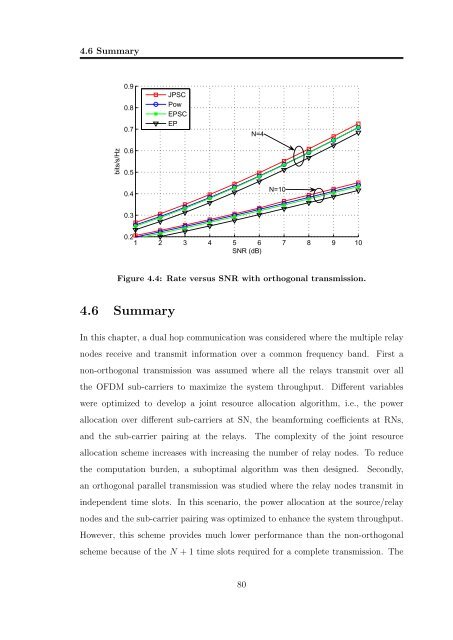Resource Allocation in OFDM Based Wireless Relay Networks ...
Resource Allocation in OFDM Based Wireless Relay Networks ...
Resource Allocation in OFDM Based Wireless Relay Networks ...
Create successful ePaper yourself
Turn your PDF publications into a flip-book with our unique Google optimized e-Paper software.
4.6 Summary<br />
0.9<br />
0.8<br />
0.7<br />
JPSC<br />
Pow<br />
EPSC<br />
EP<br />
N=4<br />
bits/s/Hz<br />
0.6<br />
0.5<br />
0.4<br />
N=10<br />
0.3<br />
0.2<br />
1 2 3 4 5 6 7 8 9 10<br />
SNR (dB)<br />
Figure 4.4: Rate versus SNR with orthogonal transmission.<br />
4.6 Summary<br />
In this chapter, a dual hop communication was considered where the multiple relay<br />
nodes receive and transmit <strong>in</strong>formation over a common frequency band. First a<br />
non-orthogonal transmission was assumed where all the relays transmit over all<br />
the <strong>OFDM</strong> sub-carriers to maximize the system throughput. Different variables<br />
were optimized to develop a jo<strong>in</strong>t resource allocation algorithm, i.e., the power<br />
allocation over different sub-carriers at SN, the beamform<strong>in</strong>g coefficients at RNs,<br />
and the sub-carrier pair<strong>in</strong>g at the relays. The complexity of the jo<strong>in</strong>t resource<br />
allocation scheme <strong>in</strong>creases with <strong>in</strong>creas<strong>in</strong>g the number of relay nodes. To reduce<br />
the computation burden, a suboptimal algorithm was then designed. Secondly,<br />
an orthogonal parallel transmission was studied where the relay nodes transmit <strong>in</strong><br />
<strong>in</strong>dependent time slots. In this scenario, the power allocation at the source/relay<br />
nodes and the sub-carrier pair<strong>in</strong>g was optimized to enhance the system throughput.<br />
However, this scheme provides much lower performance than the non-orthogonal<br />
scheme because of the N + 1 time slots required for a complete transmission. The<br />
80

















